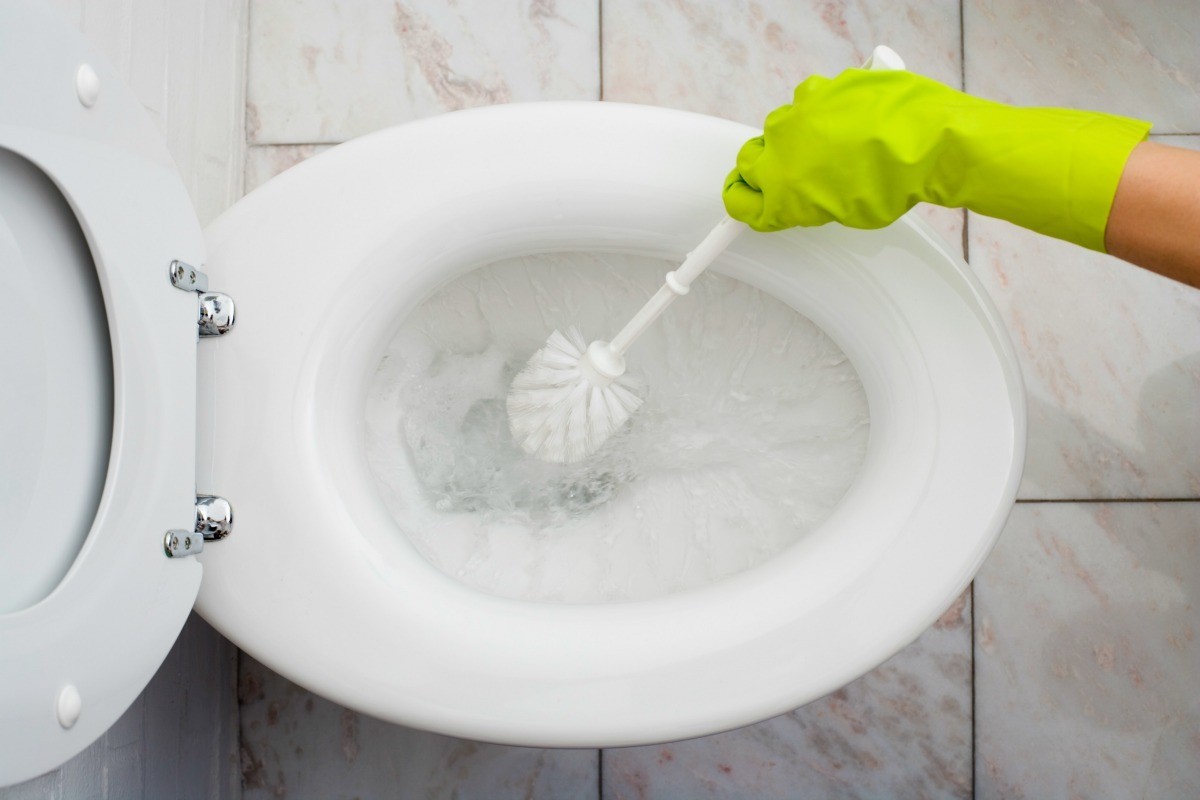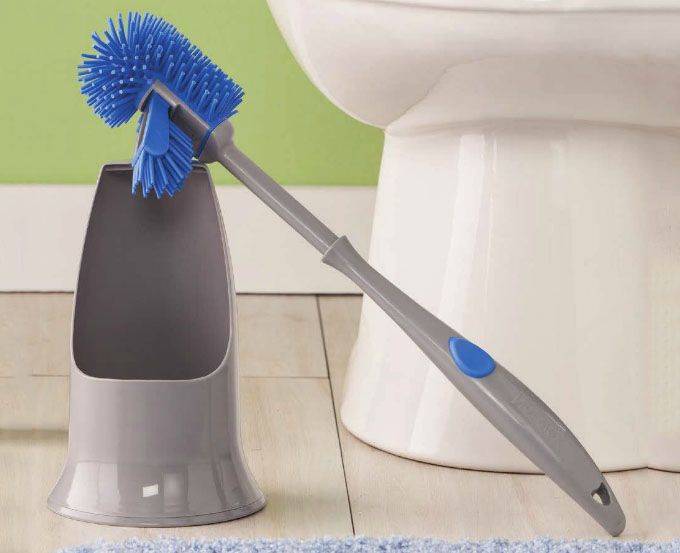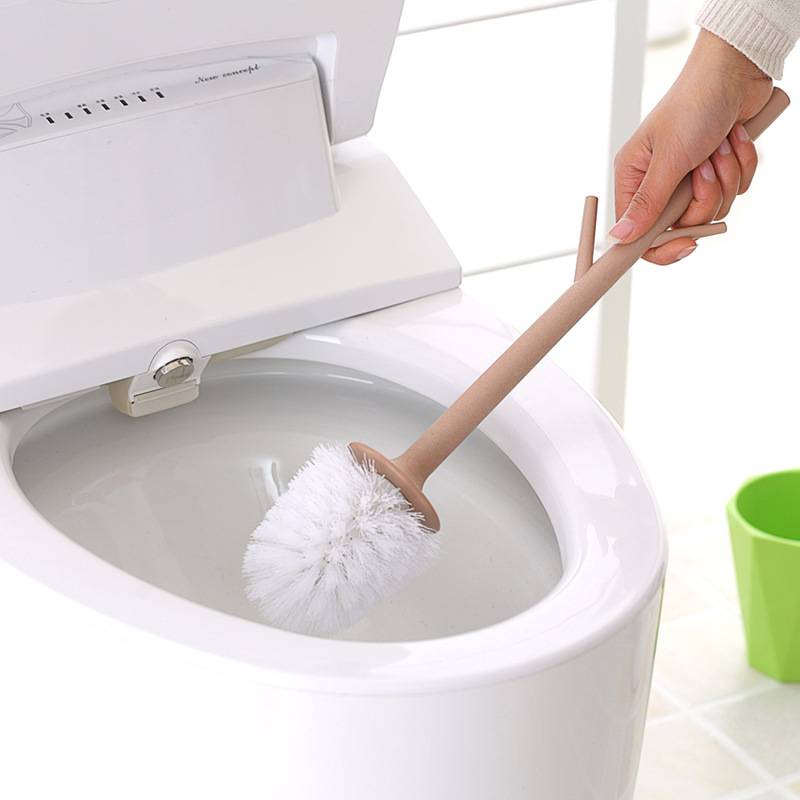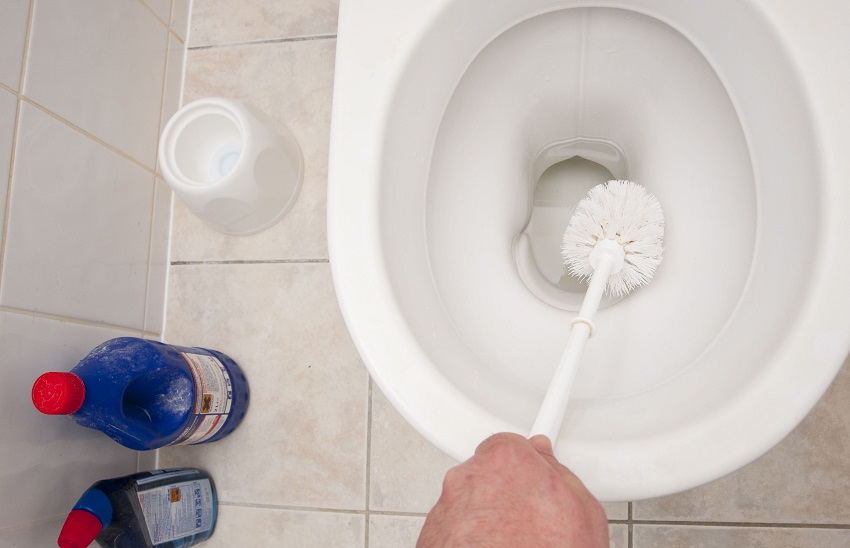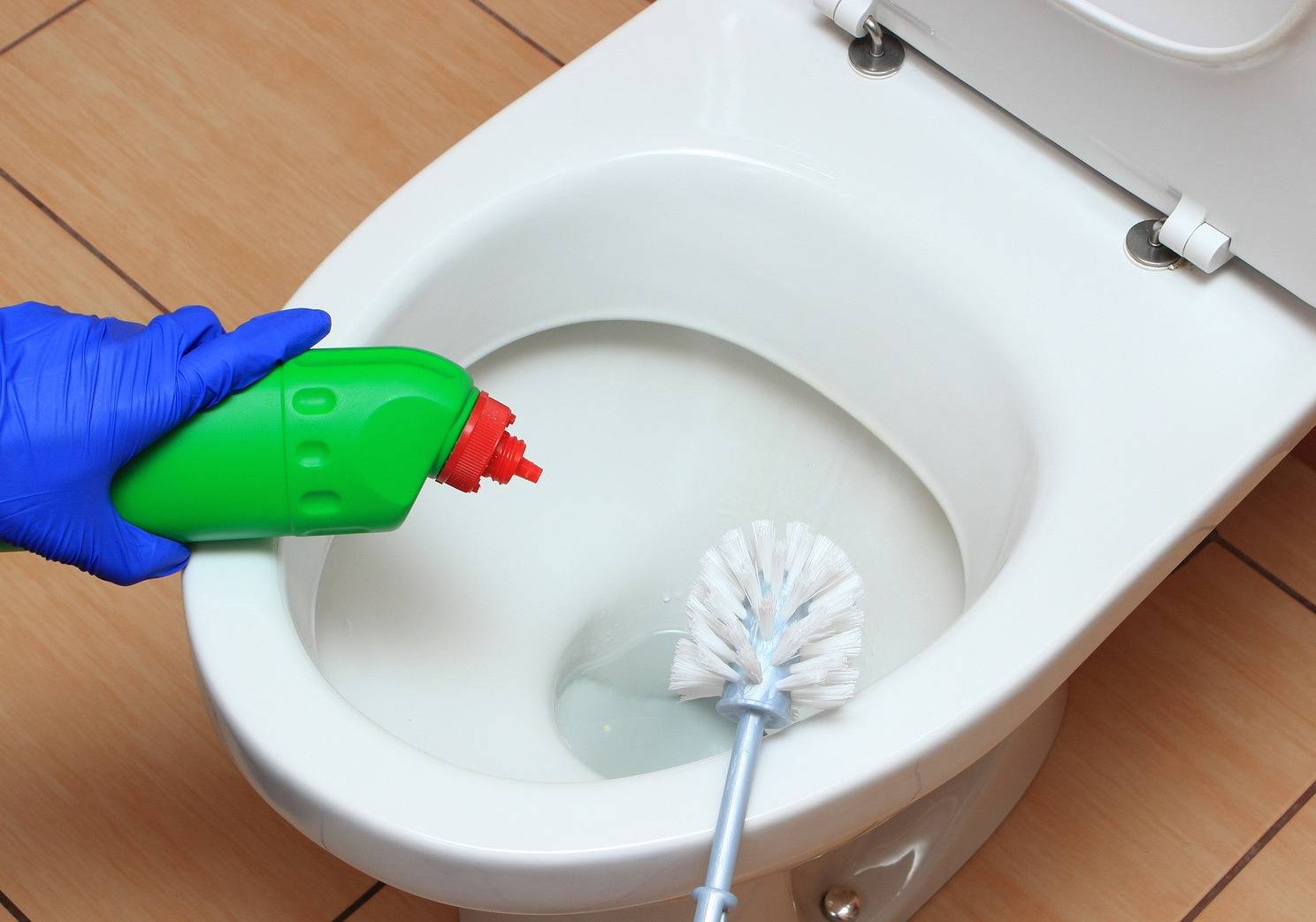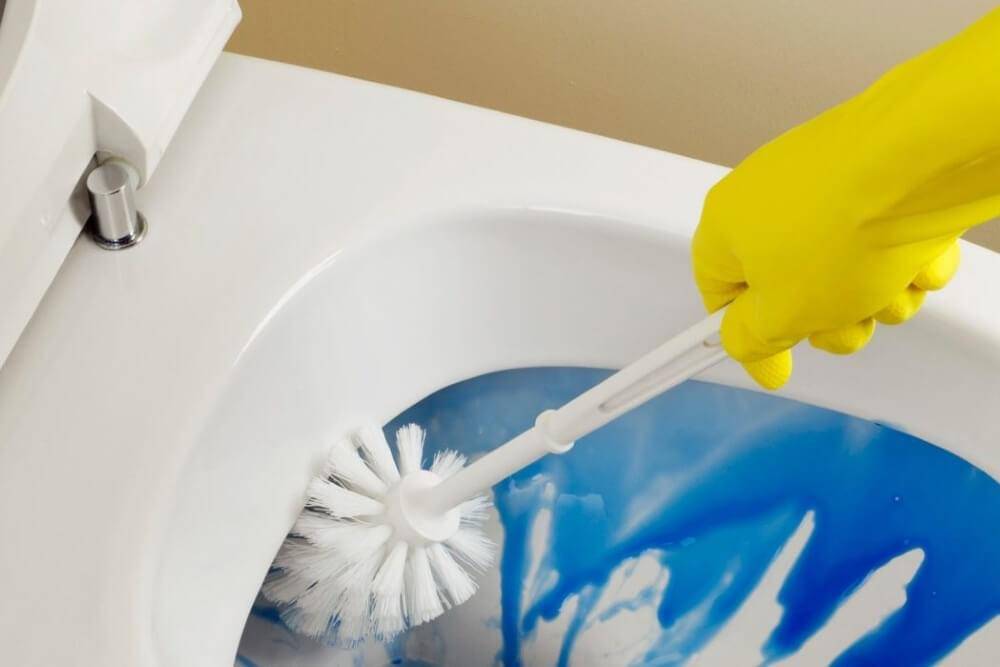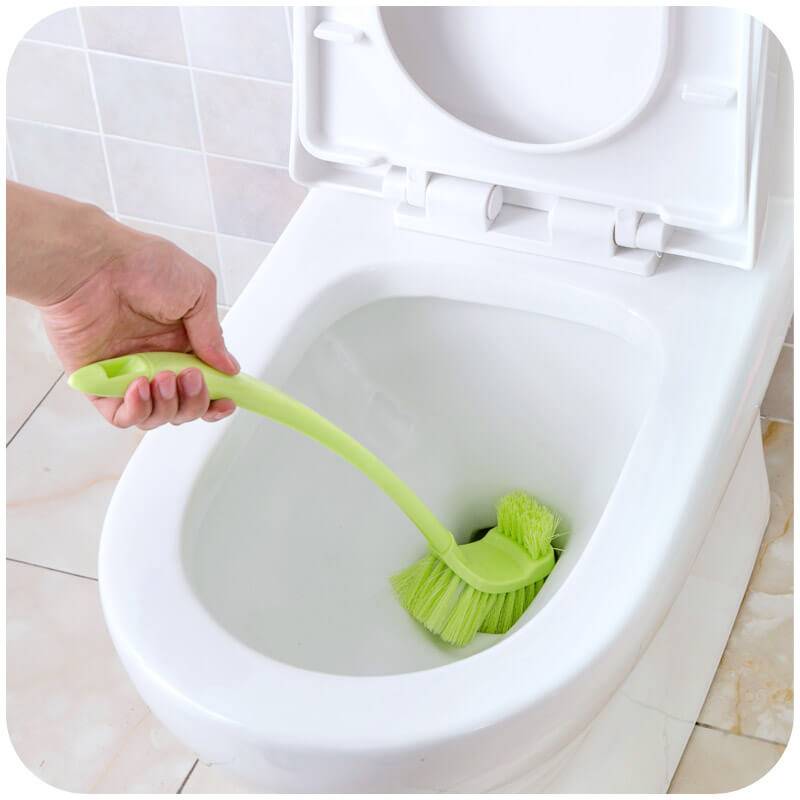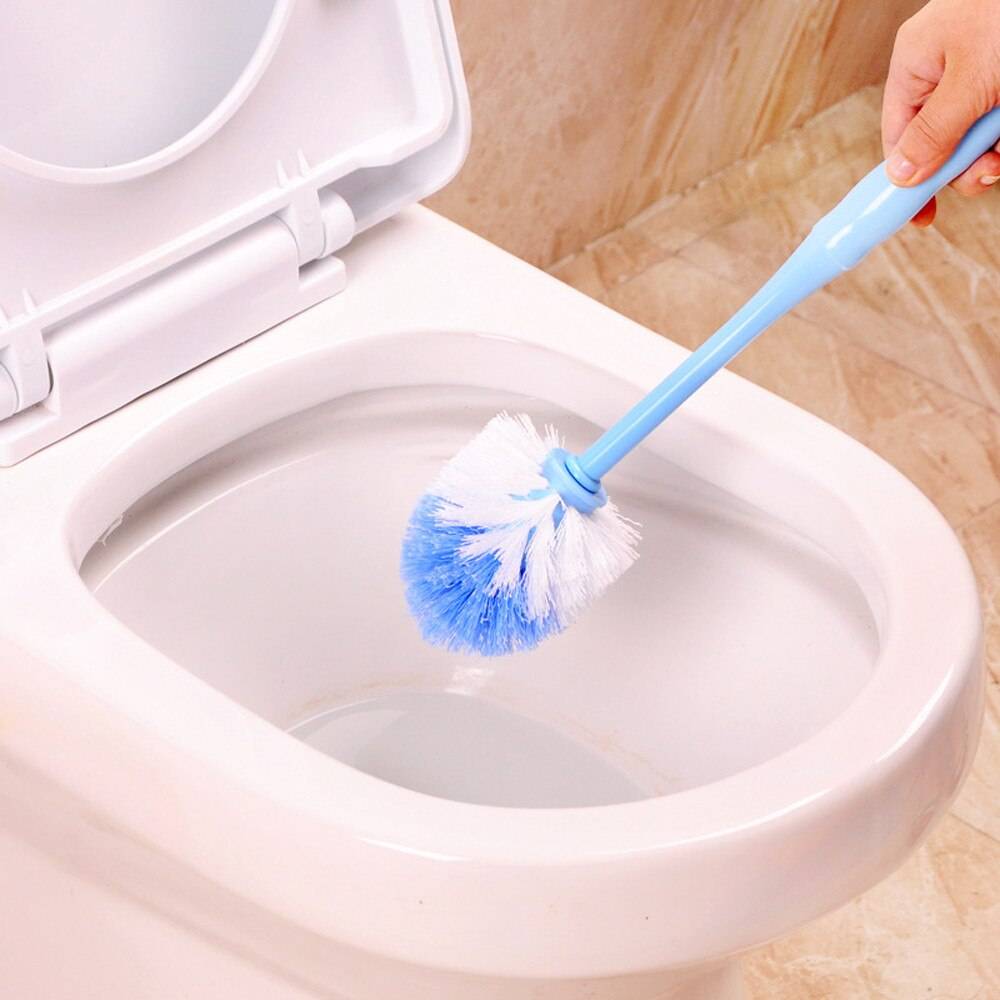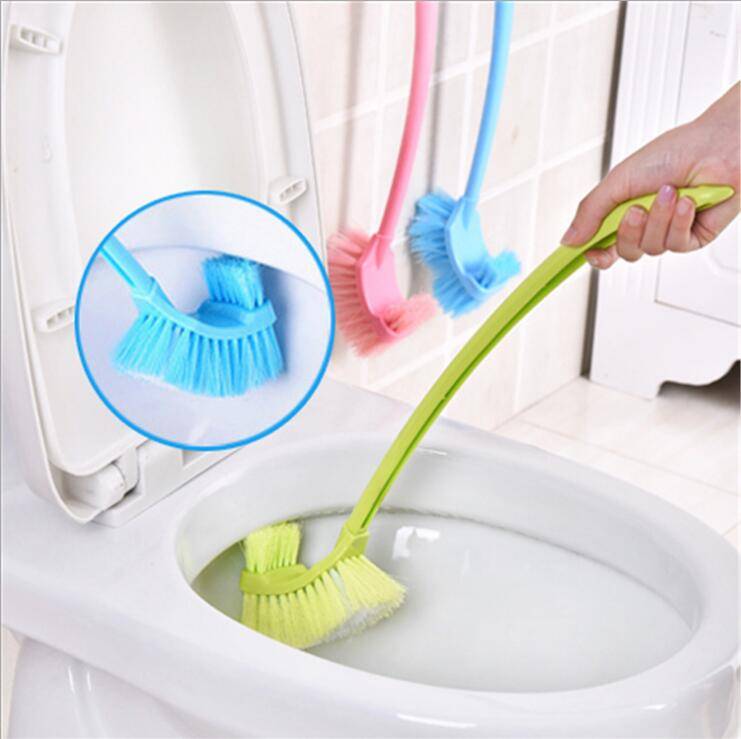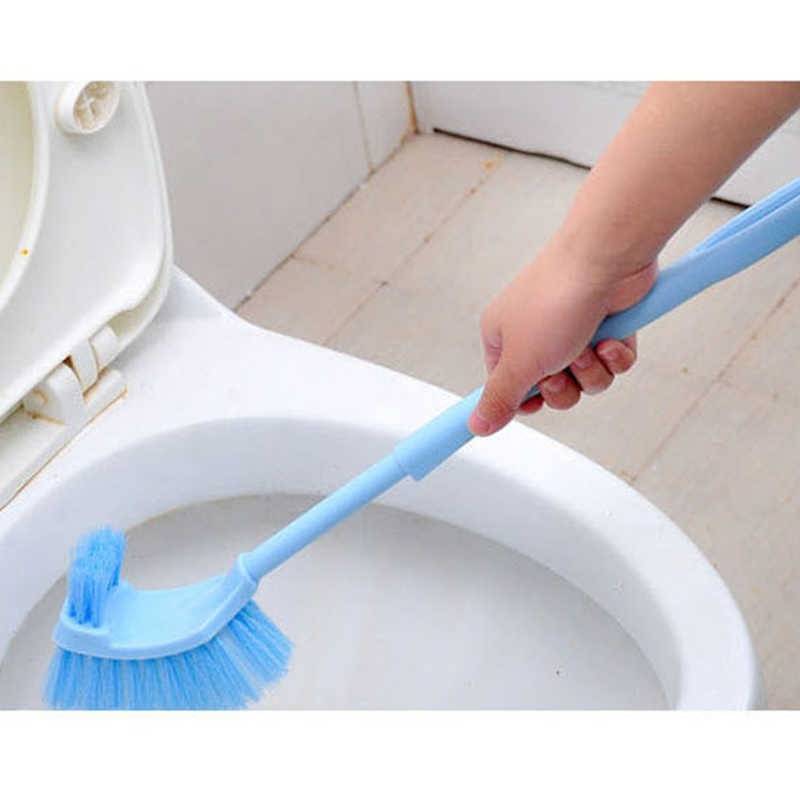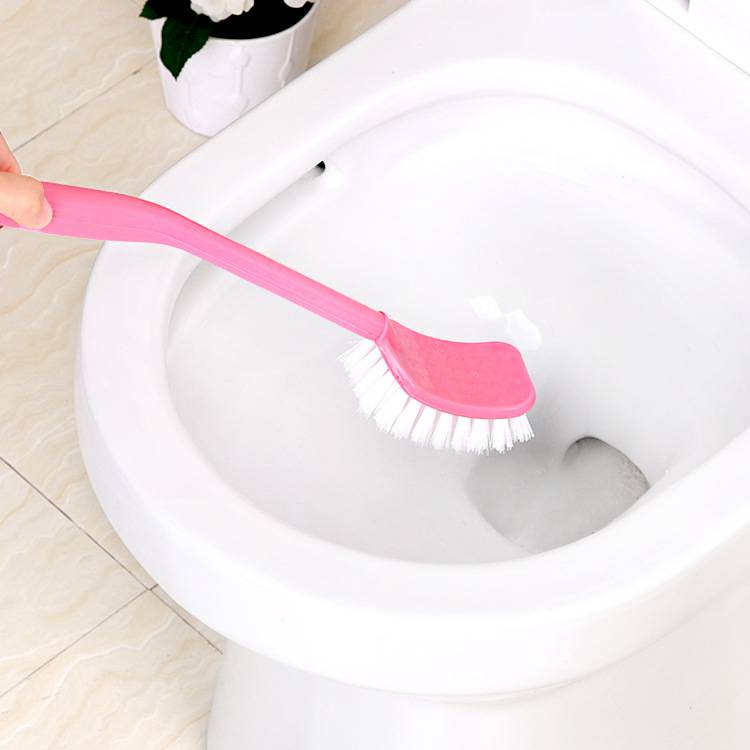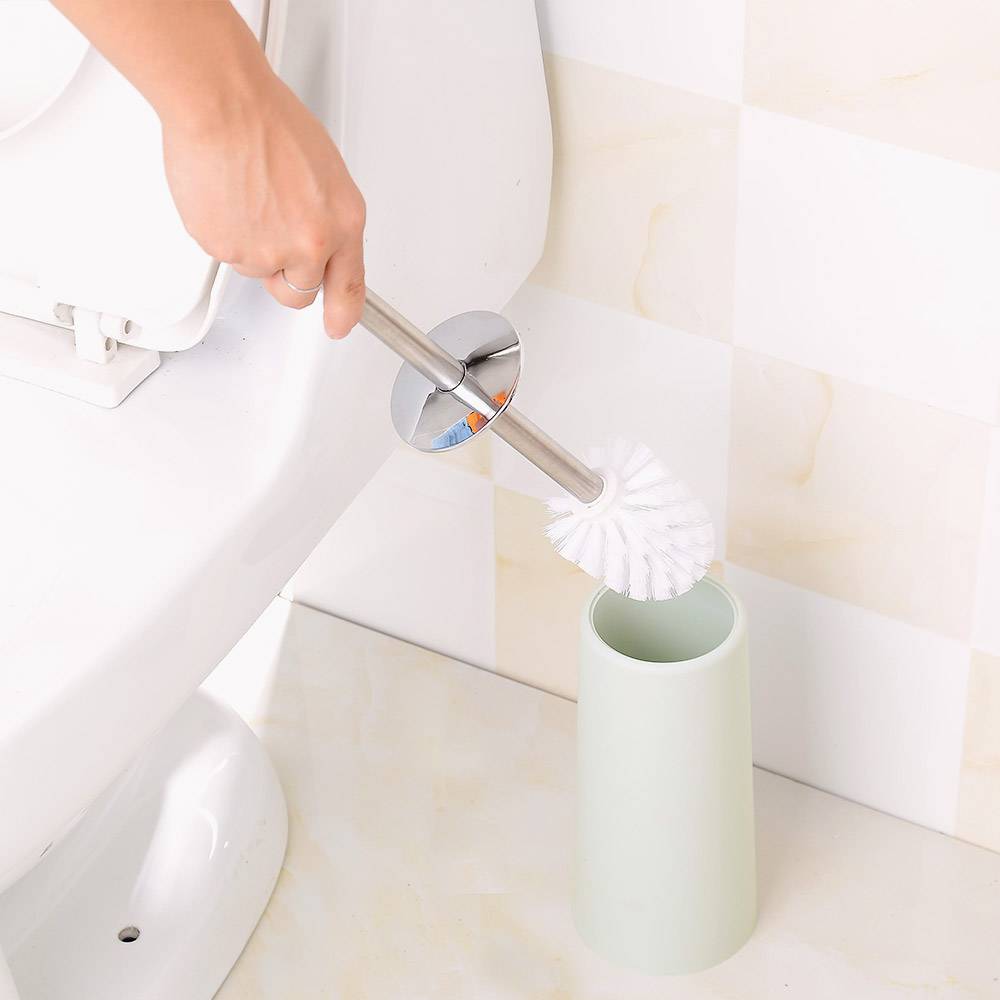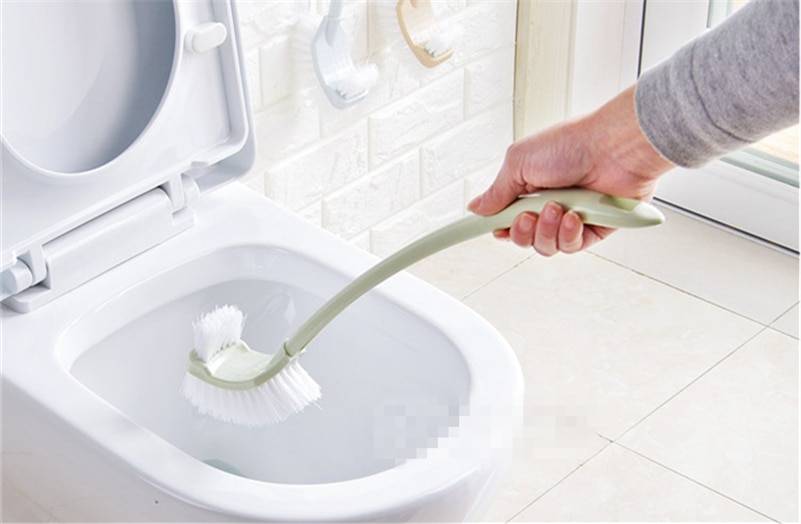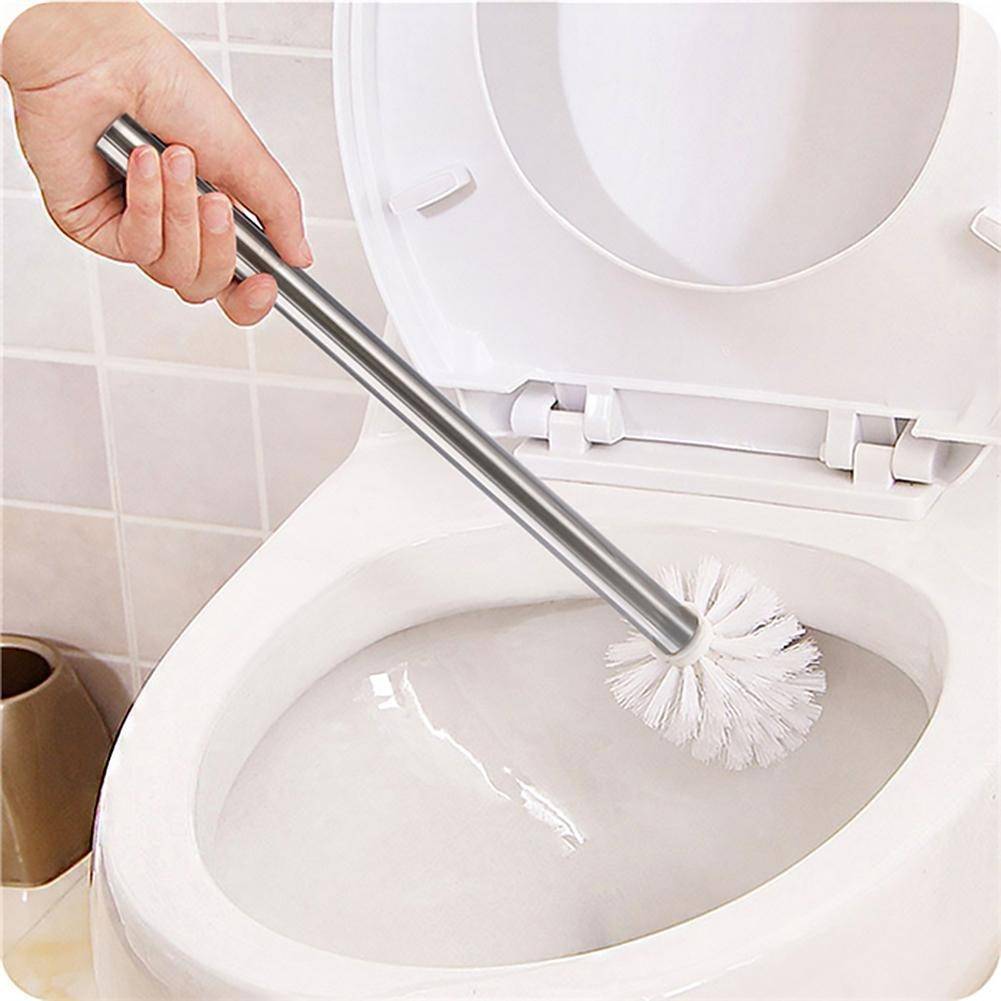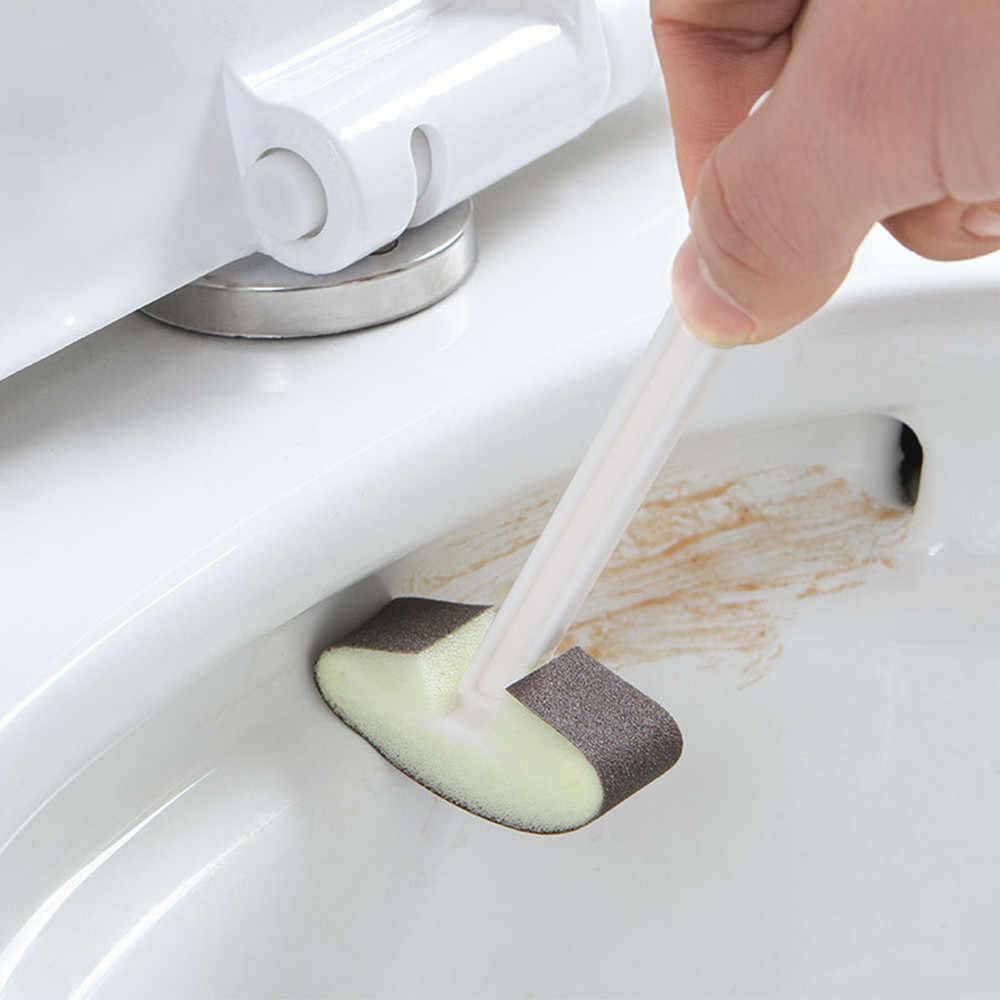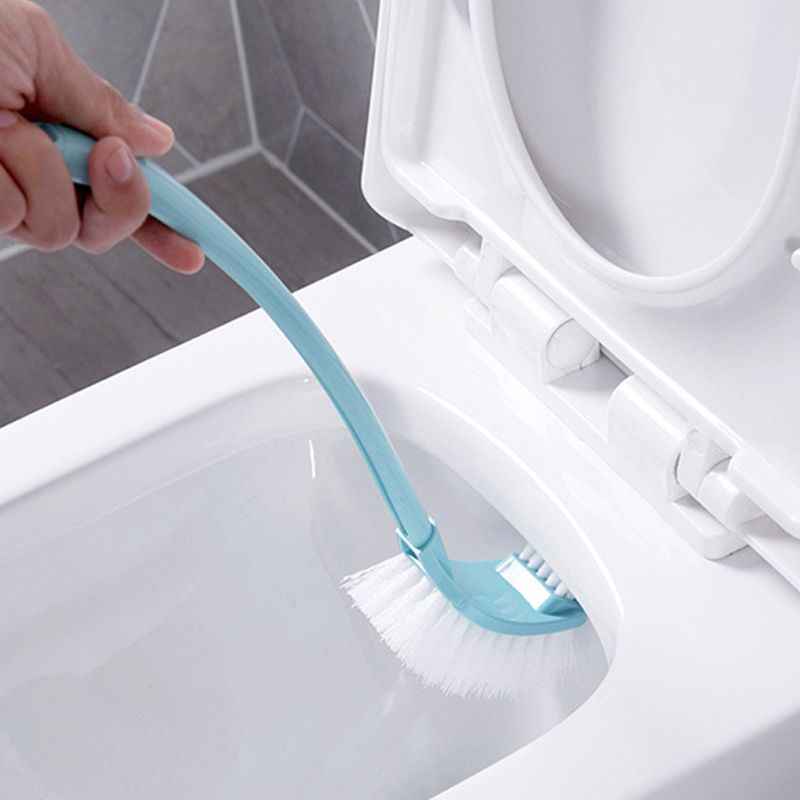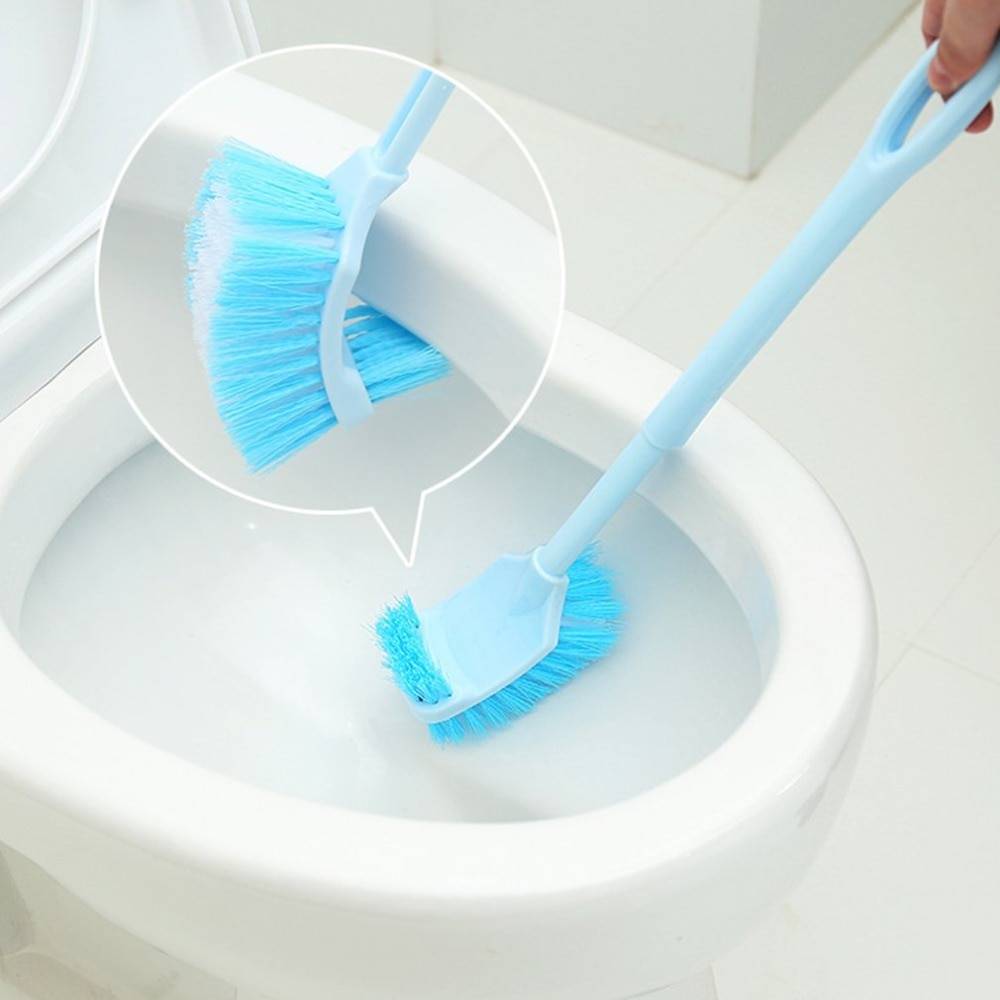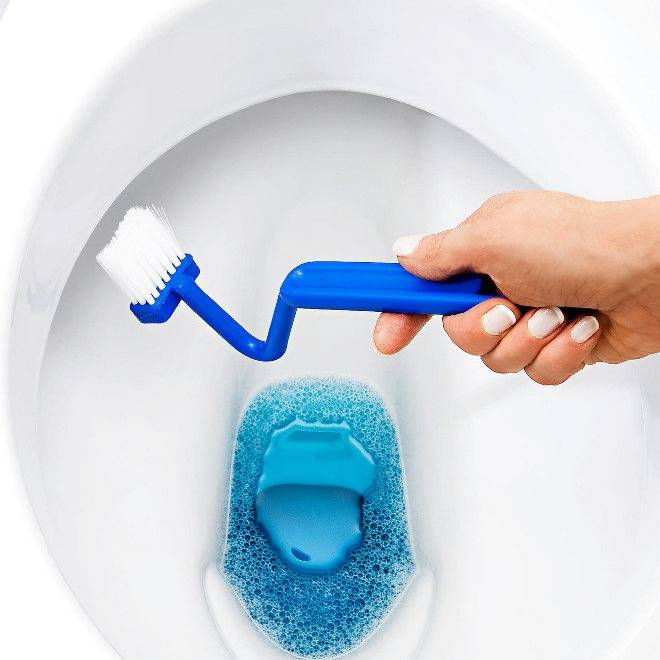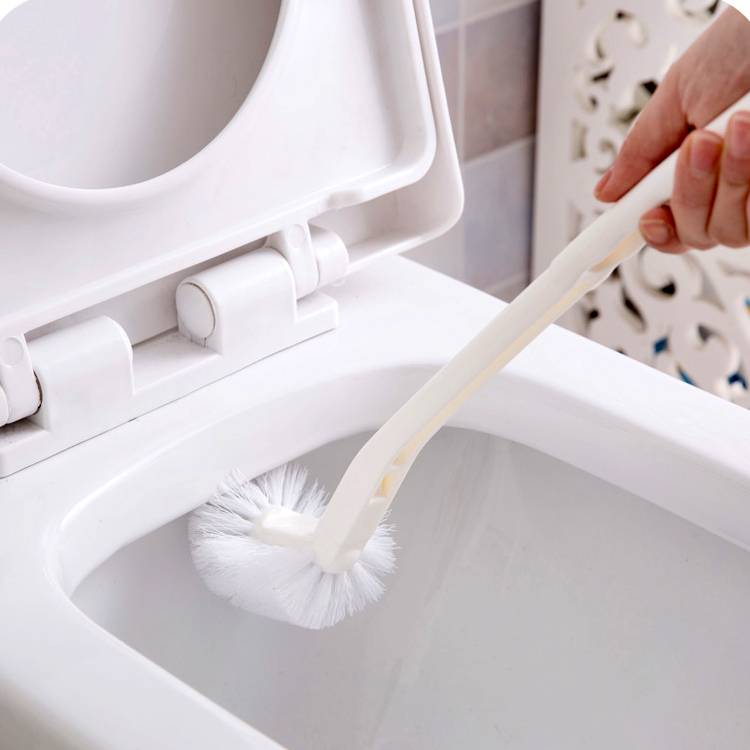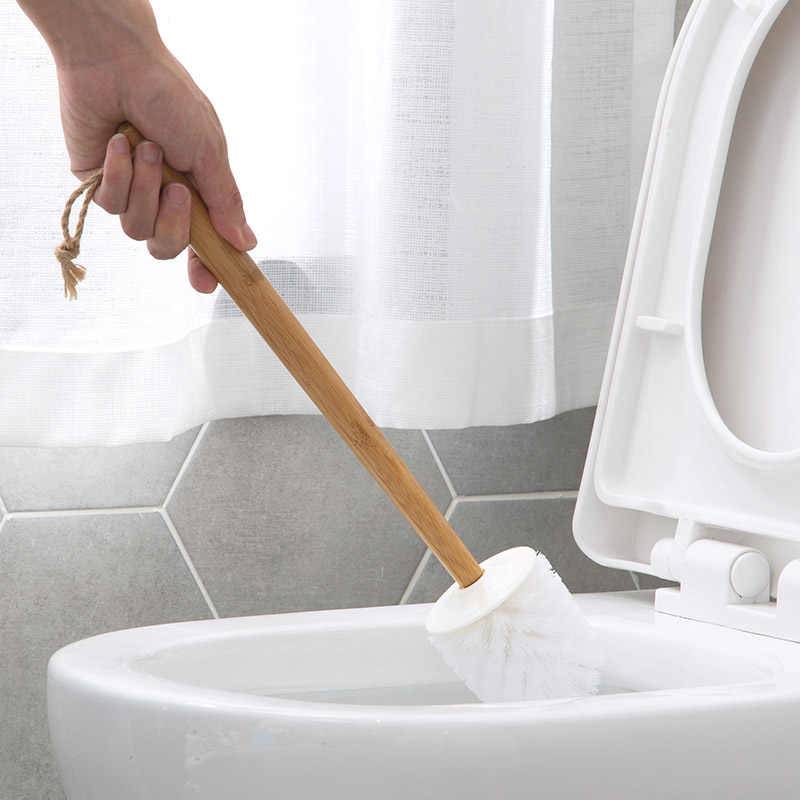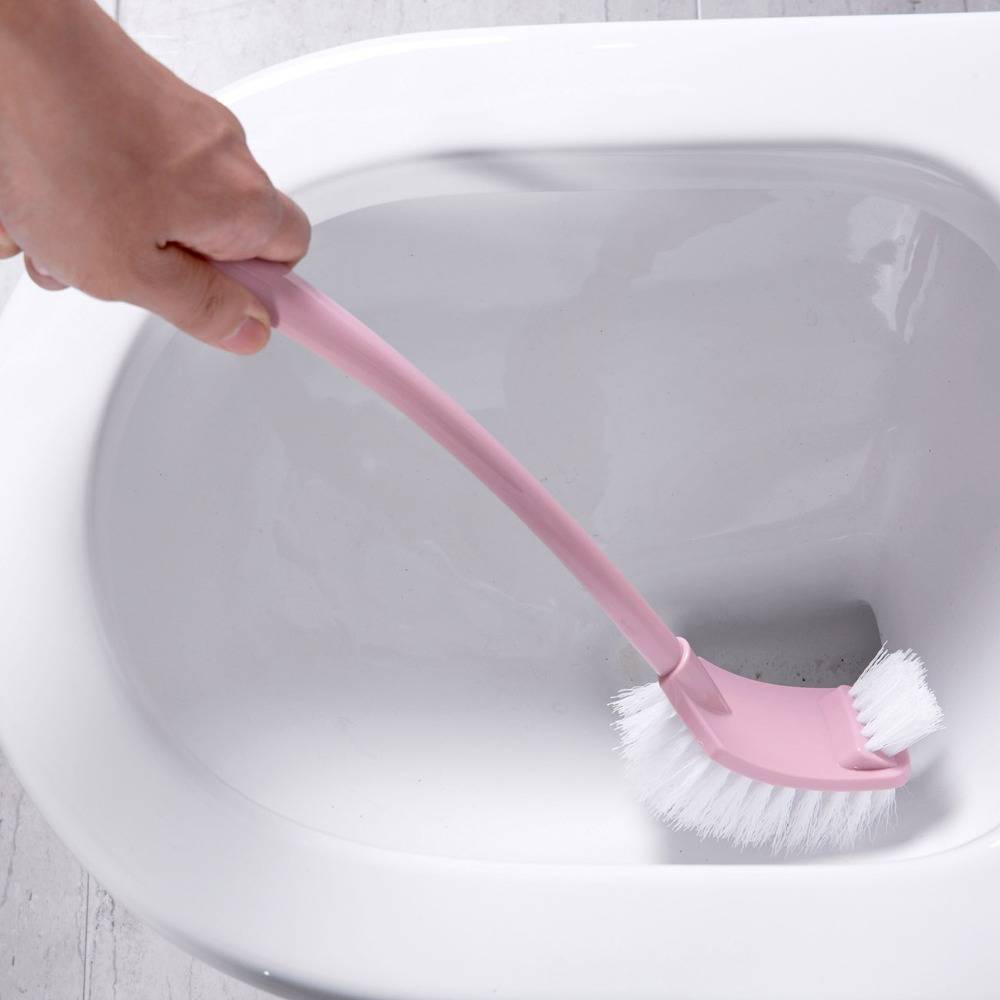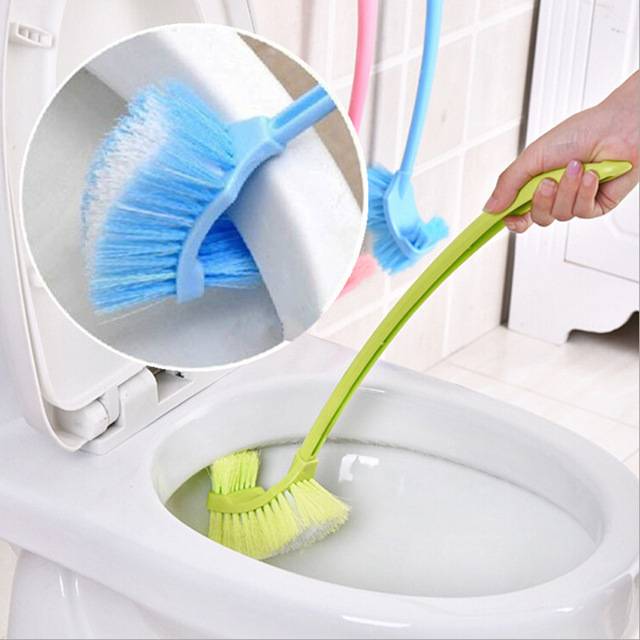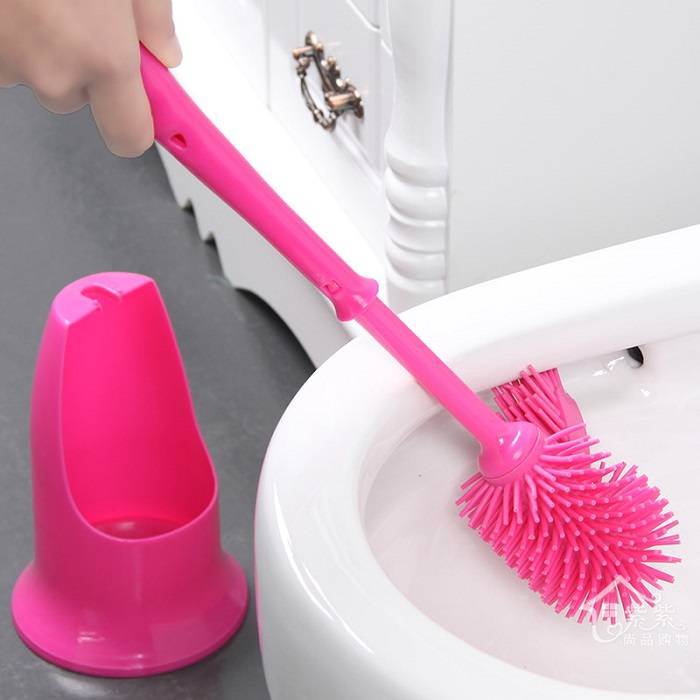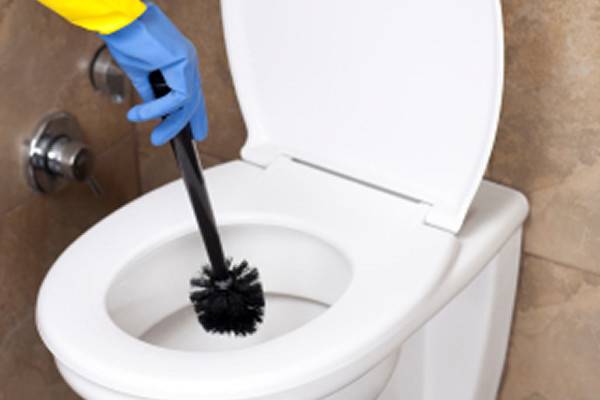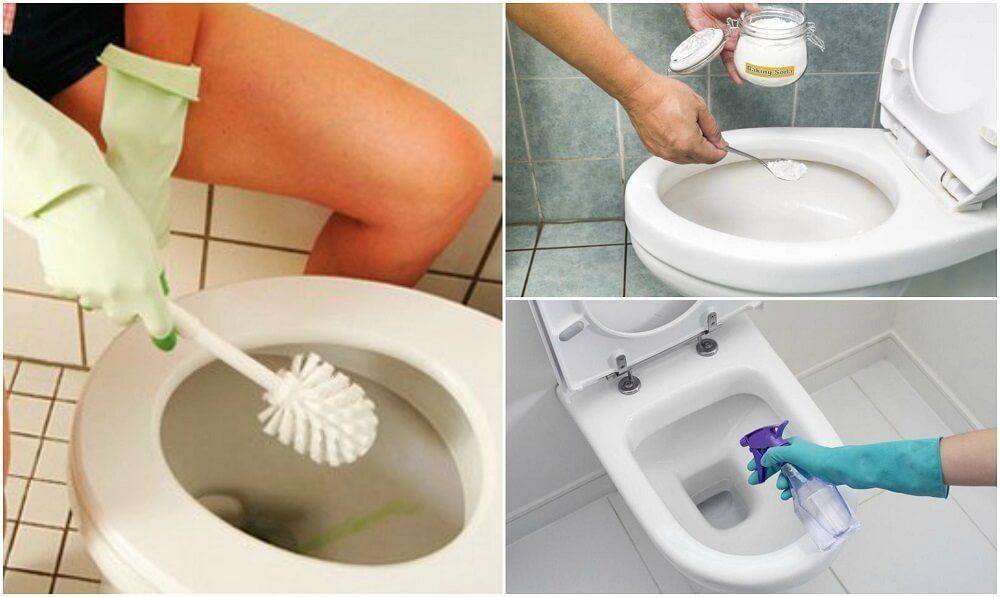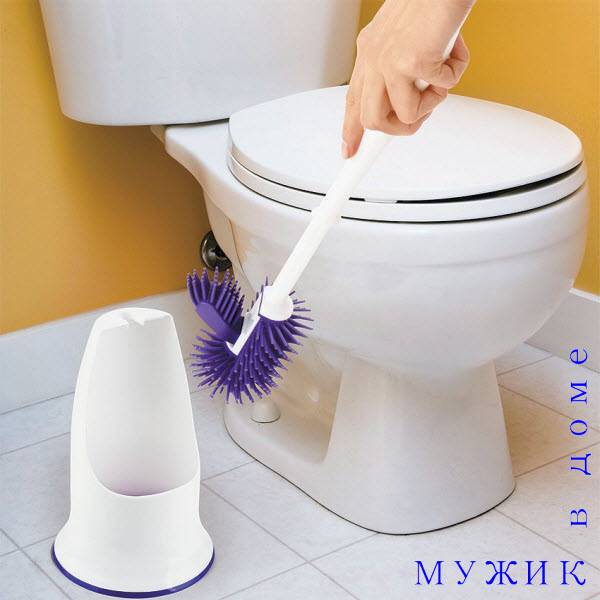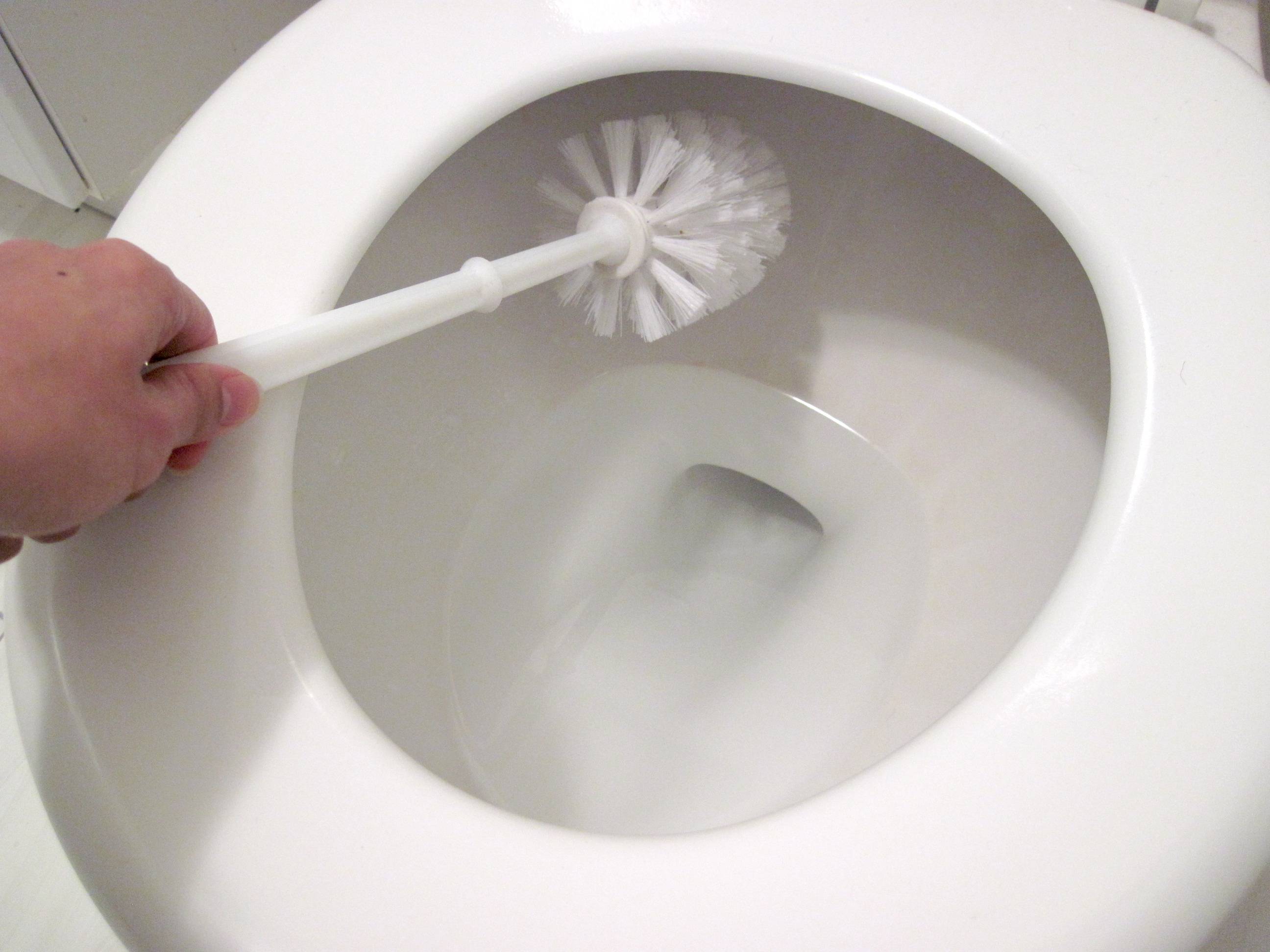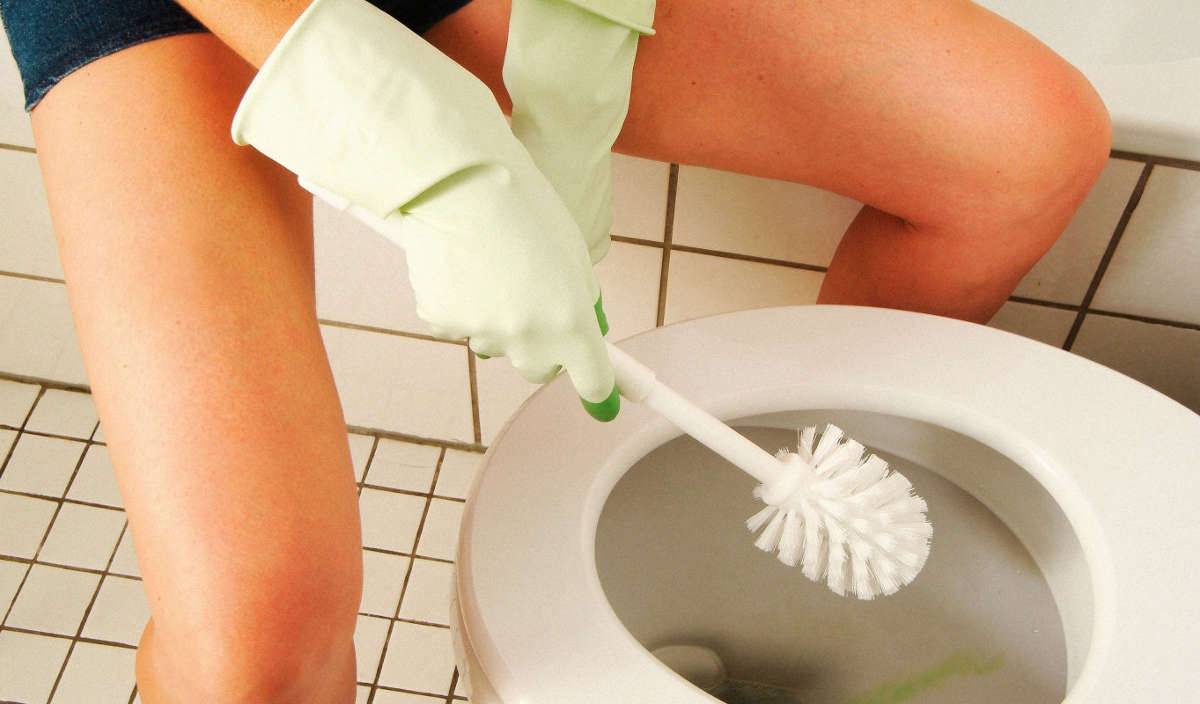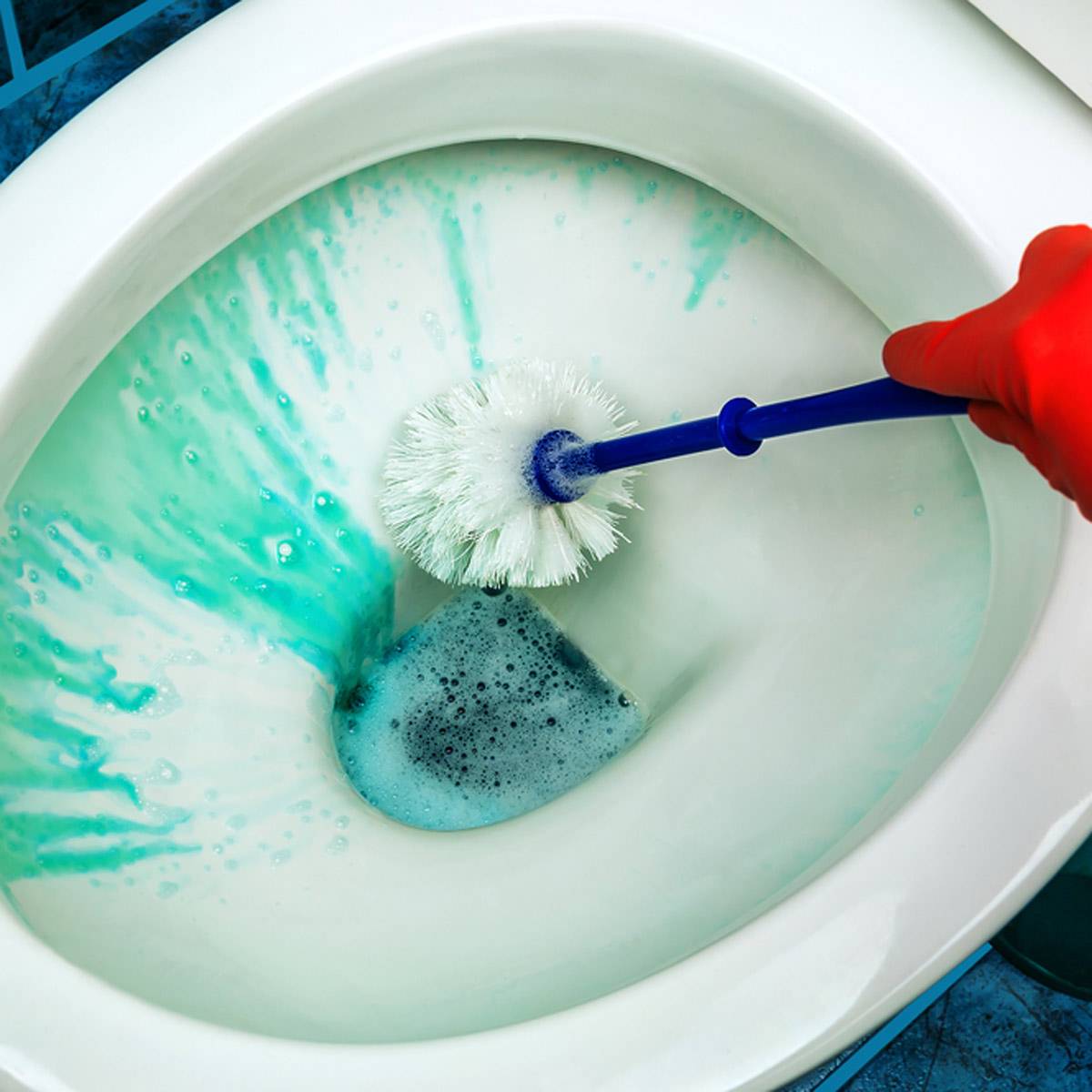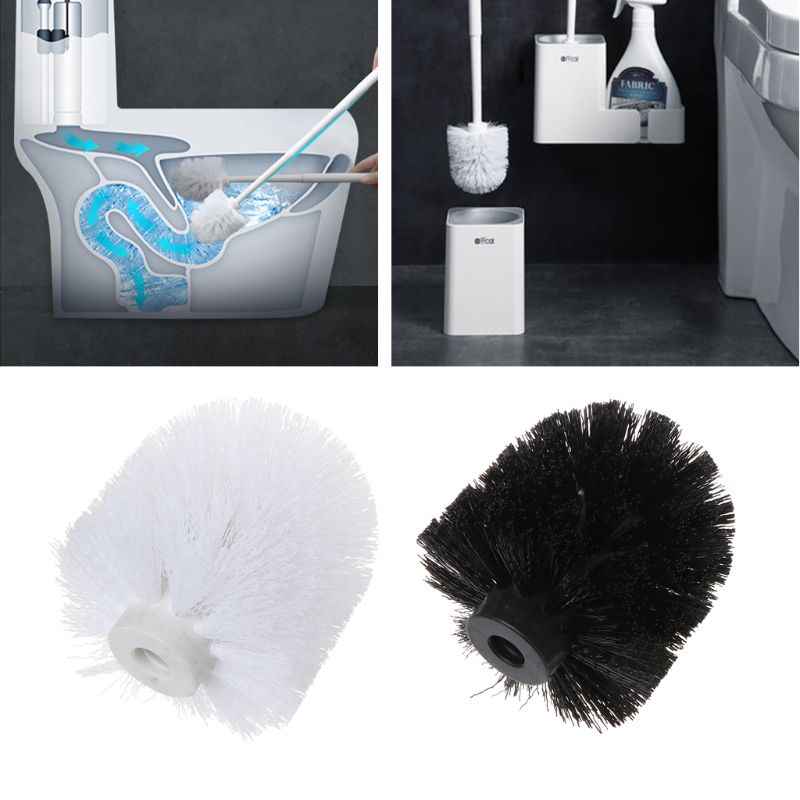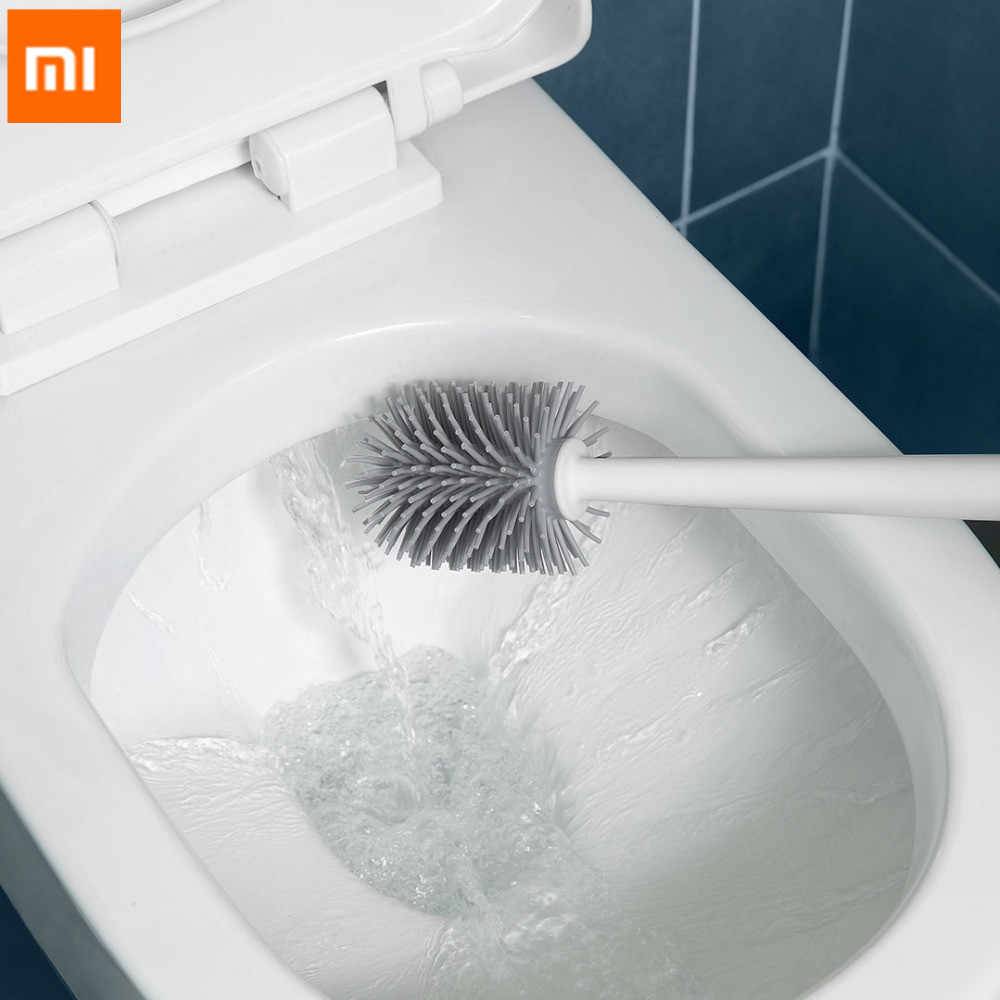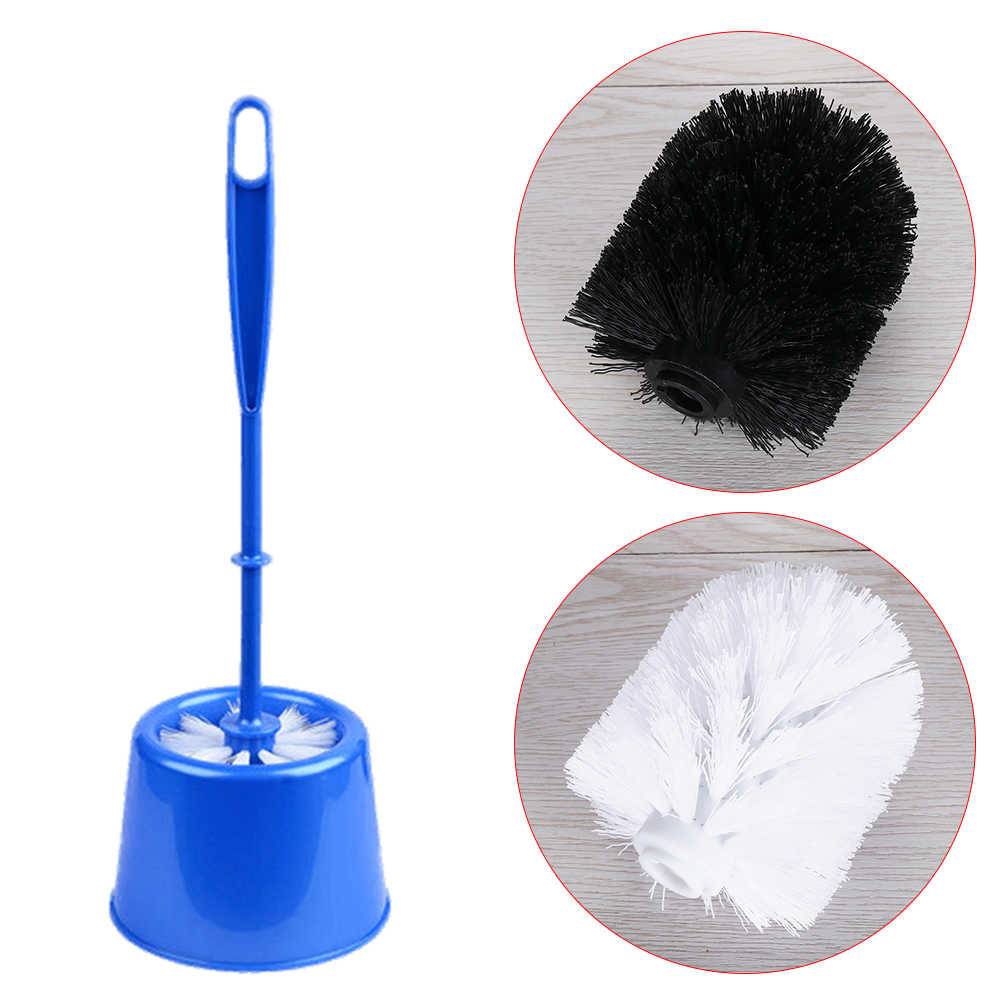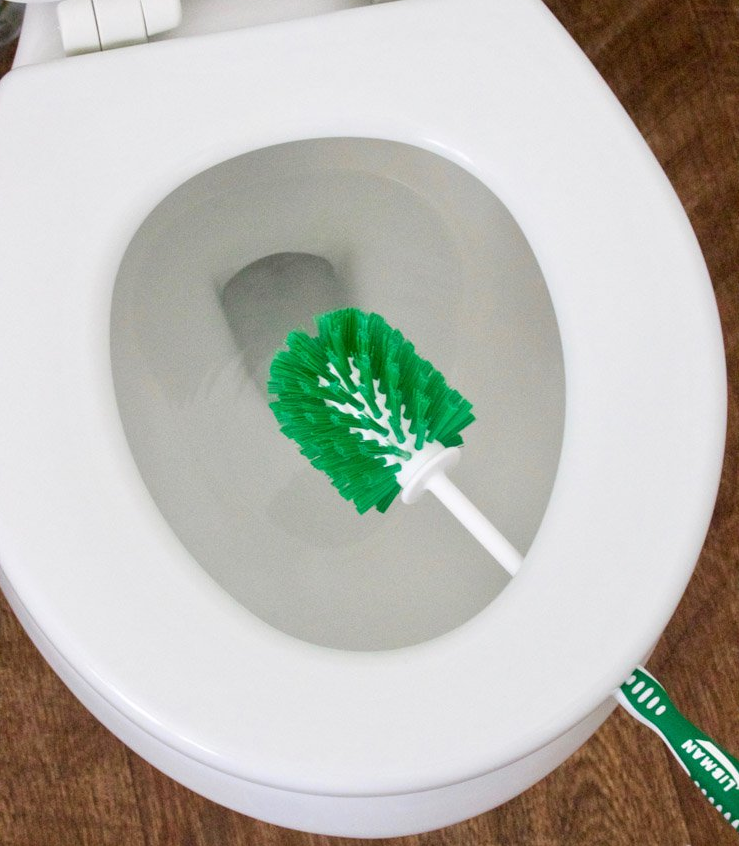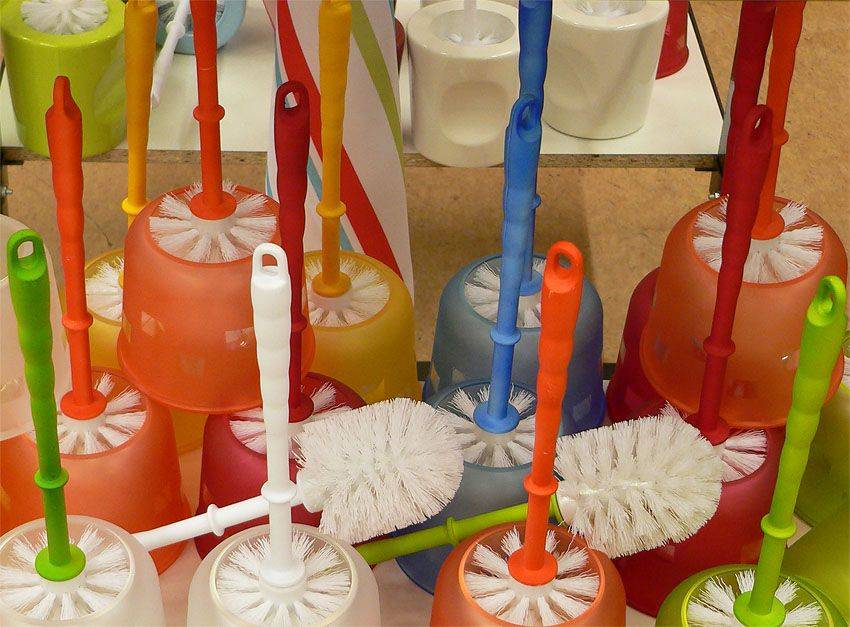How to care for toilets made of different materials?
Each material has individual properties, so you need to familiarize yourself with them:
- Porcelain. Structures made of such material quickly deteriorate when using powders with abrasive particles, because they scratch the smooth surface. Use gels!
- Faience. Plumbing made of such material is not recommended to be cleaned with hard brushes and washed with hot water, otherwise the likelihood of cracking is not excluded.
- Polymer concrete. It is recommended to clean these toilets only with liquid substances and gels.
- Stainless steel. These are durable products that do not deteriorate under the influence of aggressive alkali and boiling water, therefore there are no restrictions on their washing.
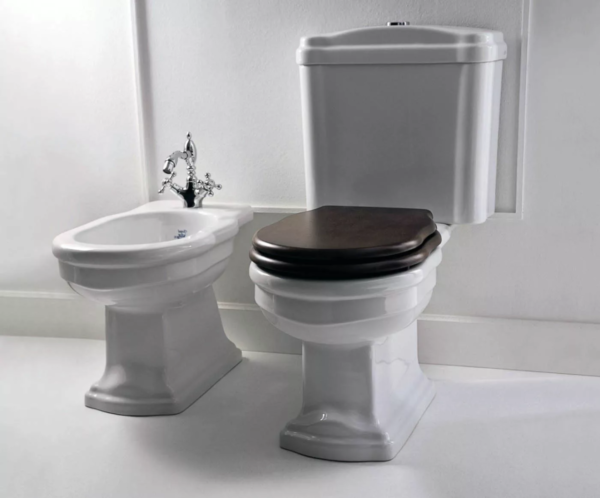 Faience plumbing
Faience plumbing
How to choose a toilet brush
Brushes that allow you to clean the toilet can be roughly divided into several types.
Location in the toilet room
- Wall-mounted, in which the brush, when not in use, is inserted into a special pedestal built into the wall.
- Floor standing, the flask of which is placed near the toilet.
- Suspended - has a flask installed on the floor, the brush itself is located on a hook that is mounted in the wall. It is located exactly under the container so that the liquid from the brush flows into it.
- Multifunctional - performs several functions at once: a paper holder, a brush and a shelf for household chemicals.
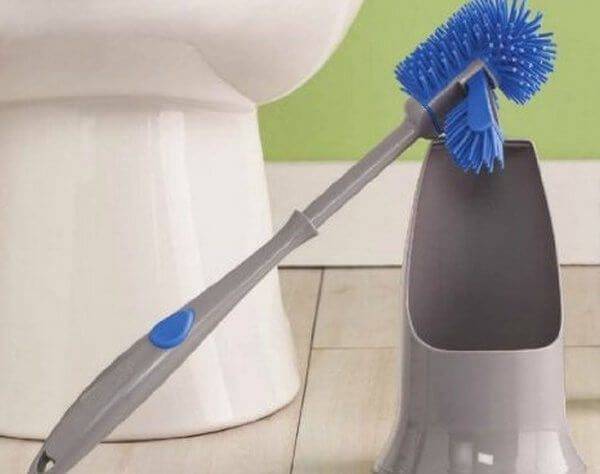
Manufacturing material
- Plastic: This brush can be completely made of plastic, or its handle can be metal and all other parts are plastic. These are the cheapest type of brushes, however, they are not reliable enough.
- Glass - in fact, only a flask is made of glass, and the brush itself may have a handle made of metal, and the pile is made of synthetic fibers. Quite comfortable and hygienic.
- Silicone is a novelty in the market of sanitary accessories, and, moreover, it is quite hygienic - this material does not promote the growth of bacteria and does not absorb water.
- Acrylic is quite durable, it can have a variety of colors or be completely transparent. It is recommended to wash it only with gentle agents, therefore it is not suitable for processing with chlorine-containing substances.
- Metal or stainless steel: very practical, easy to use, affordable.
- A ceramic brush, which has not so much a functional purpose as an aesthetic focus.
If you are going to purchase a brush for cleaning the toilet, you should pay attention to a number of important features:
- Ergonomics of the accessory - it should fit comfortably in the hand, the handle should not be too long or, conversely, too short. The accessory should not bend, its handle should have a smooth surface.
- The brush head must be made of artificial material of a sufficient degree of rigidity, otherwise it will not be able to perform its main function.
- Special attention is paid to accessories that can be disassembled into parts. This makes it convenient to wash them and disinfect all parts of the structure.
- The brush should in its style be combined with other interior items of the toilet room and not look like an alien element there.
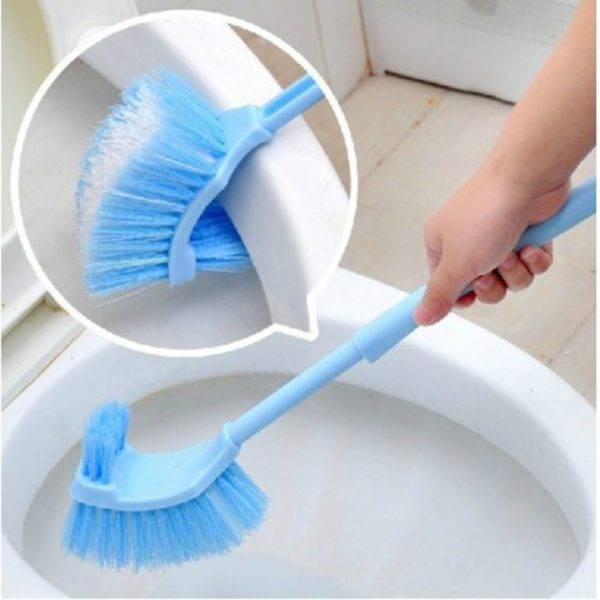
Types of toilet brushes
Yes, and such a simple attribute has its varieties. Moreover, the brushes differ both in material, and in storage method, and, if you like, in color.
In order to choose what will be the best option, in your opinion, you need to study what the market for these accessories offers.
According to the material of execution, it can be:
- plastic;
- made of stainless steel;
- ceramic;
- chrome-plated;
- silicone.
Depending on the quality and reliability of the selected material, the price of this item also varies.And if an ordinary plastic brush will cost very little money, then, for example, a metal toilet brush will be significantly higher in price.
What to opt for is the master's business. Everyone has different needs and opportunities. But it is clear that a quality item should be more expensive.
In addition to this distinctive feature, the toilet brush may differ from another in the way of storage.
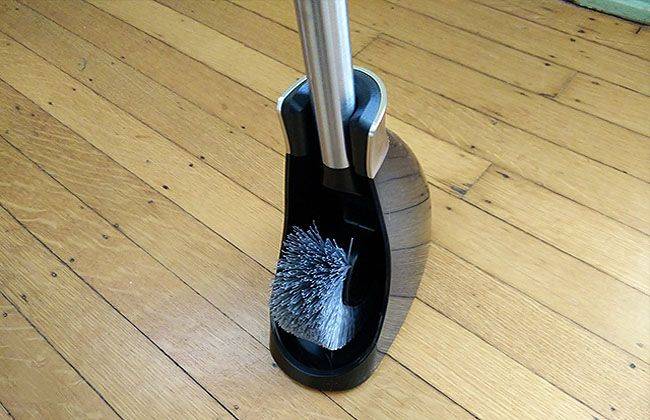
Floor brush
Floor. We can say that this is a classic type of toilet accessory. It can also be called glass.
Because the toilet brush is stored in a special bowl, which also serves as a stand. It is installed directly on the floor in any convenient place.
But while such a traditional floor toilet brush is very popular, it is still considered the least hygienic option.
In a stand, it is stored in a dirty, humid environment, not ventilated, which is a favorable factor for the multiplication of pathogenic bacteria and harmful microorganisms.
Wall. This toilet brush differs little from the floor model. Only the stand in this configuration is not located on the floor, but is attached to the wall. The disadvantages of this brush are the same as in the previous storage method.

Hanging brush
Suspension. This storage method is considered the most acceptable.
In this case, the brush is hung on a special hook, and the water flowing from it falls into the receiver glass, which is installed directly under the brush.
Thus, the ventilation of the hygiene item is ensured.
And if the ruff is well washed, then with this method of storage it will accumulate the least amount of bacteria.
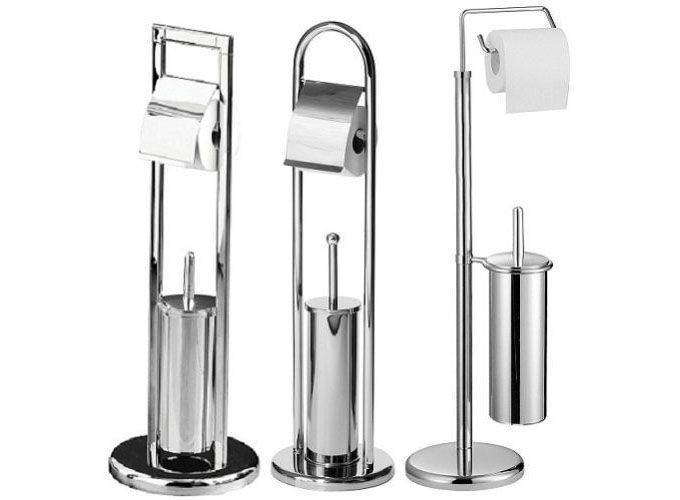
Multifunctional brush
Multifunctional brush model.
The modern market offers original options for toilet brushes that combine other functions.
For example, the combination of a brush and a toilet paper holder.
It is a high stand on which two stands are installed.
If there is not enough space in the toilet room, then thanks to this design, the problem of placing the necessary accessories is solved.
Sometimes holders for containers with cleaning agents or for newspapers may also be included in the package.
Removing thick plaque with strong acids
If no folk and cleaning products help, strong acids can be used. These are extreme measures that should be rarely resorted to and strictly observe the exposure time, since such chemicals can corrode enamel and harm pipes and plastic parts.
Oxalic acid
Medium toxic organic acid. A popular sanitary ware cleaner in the days of our grandmothers. Provides perfect whiteness and effectively removes stone. Nowadays, it can be purchased at hardware stores. Before use, read the instructions carefully and put on thick rubber gloves.
Mode of application:
- Sprinkle powdery acid on a damp cloth.
- Apply to contaminated areas. If you need to clean the drain, dissolve it in water.
- Wait 1 hour, during which time the plaque will dissolve.
- Rinse thoroughly with water using a brush.
Orthophosphoric acid
It is a medium-strength inorganic acid. With the help of it, you can not only clean the toilet from the stone, but also remove rust from the internal parts of the tank. The main advantage of this acid is that it does not damage rubber and plastic elements. Mode of application:
- Pour 100-150 ml of acid into the tank and drain hole
- Wait 15 minutes
- Rinse off with plenty of water and clean with a brush.
Hydrochloric acid
It is a very strong toxic agent.
Will remove stone instantly, but should be used with extreme care. Wear protective goggles, respirator and thick rubber gloves before use
The fumes of this acid are also dangerous!
Mode of application:
- Apply liquid to the walls and pour half a glass into the drain hole.
- The exposure time is 10 minutes.
- Rinse with plenty of water
Electrolyte
Battery electrolyte is produced on the basis of sulfuric acid, and you can find it in any shop for motorists. This powerful and very dangerous agent perfectly dissolves limescale. and urinary calculus... It can only be used on rare occasions. The method of application is similar to the method with hydrochloric acid: apply, leave for 10-15 minutes and rinse with water. When applying, observe all safety measures, avoid splashing the product, as you can get chemical burns.
Proper storage of the toilet brush
The toilet brush should be washed regularly to keep it clean and prevent the spread of germs. However, improper storage can lead to the fact that the entire toilet room, including its walls and floor, will have to be washed.
In order to prevent such a situation from arising, you need to carefully consider the location of this useful accessory:
it should not touch the surface of the floor and walls;
if the brush is suspended, there must be a container under it for collecting liquid;
the brush should be in the immediate vicinity of the toilet so that water does not drip from this accessory onto the floor while it is being carried to the storage location;
it is important to explain the rules for using a brush to all family members so that you do not have to organize the cleaning of the entire bathroom.
Whichever toilet accessory is chosen, it is important to organize correctly storage place for him, thoroughly and regularly clean it from dirt. In addition, it is important to throw away the old brush every 6 months and purchase a new accessory.
Subject to these rules, the brush will perform well its functions and will not cause health problems.
How to use the toilet brush correctly

It would seem that there is nothing difficult here to further focus on this, but there are a number of points that you should know and observe. Here's how to use the toilet brush:
- Do not take the brush close to the brush for hygiene reasons, there may be contamination with pathogens, do not get dirty. The place where you should take it in your hands is structurally designed in the form of a pen or separated by color.
- Moisten it with water and add disinfectant solution or powder. The antibacterial agent can be added directly to the toilet or to the storage glass.
- Wipe the dirt off, working gently to avoid splashing your hands and clothing.
- Wipe off slowly, lightly.
Flush everything down the toilet, preferably flushing and rinsing again, with a brush in clean water when draining to remove any dirt between the bristles.
Shake the brush to remove excess moisture and place it in storage.
Shake gently as close to the drain as possible without splashing drops all over the toilet, without smearing the walls. The remaining dirt on the walls will be an additional source of contamination and a source of infection.
Do not drip the brush onto the floor; any remaining liquid should drain into the glass.
Instructions for using the toilet brush
Preparation for use
(The toilet brush has a distinction between "top" and "bottom."
After the end of defecation, the toilet brush must be taken by the "top" and a quick glance to establish the extent of the toilet bowl pollution.
Exploitation
Now you need to lower the bottom of the brush into the toilet and remove the dirt with cleaning movements.
There should be no toilet paper in the toilet. Soggy toilet paper tends to get stuck in the brush bristles.It is very likely that the unsightly appearance of such a brush will discourage subsequent toilet visitors from using it.
Completion of use
The toilet brush often gets very wet. To prevent the liquid from dripping onto the floor, tap the edge of the toilet bowl with a brush several times (danger of splashing!), And then immediately place the brush in the holder.
Experienced users can remove water using centrifugal force by dexterously and quickly rotating the brush between the fingers of one hand (similar to spinning a whirligig). When doing this, make sure that the brush brush is completely below the top edge of the toilet (risk of splashing!). This method may require some training, but it is virtually silent and will not damage the brush brush, seat or toilet cavity ...
Basic ways
To clean the brushes, the following products are mainly used:
- Domestos;
- Silith;
- Faberlic for toilets;
Table vinegar, which simultaneously suppresses the activity of pathogenic microorganisms: staphylococci, streptococci and others, is no less effective from pollution.
Chemicals
Regardless of the type of household cleaning product chosen, you can clean the toilet brush using one of the following methods:
- Pour the chemical into a container and place the toilet cleaner in there for a few hours.
- Pour liquid into the toilet and thoroughly clean the device with a brush.
- Pour the product into the glass in which the brush is stored and let it stand for at least 15 minutes. This cleaning option is considered more preferable.
Chemicals for household appliances are highly effective in the fight against pollution and pathogenic microorganisms. However, such products in concentrated form can be harmful to health. Therefore, when using household chemicals, it is recommended to use protective equipment: gloves, face mask, and so on.

Domestos
Domestos is considered the most common household chemical. This product is capable of cleaning surfaces with various types of dirt and bacteria. The main disadvantage of Domestos is that the liquid emits a pungent and unpleasant odor. Therefore, after applying the product, it is recommended to leave the toilet.
Silith
Silite, like Domestos, helps clean surfaces of various types of contaminants. In terms of efficiency, both products are comparable to each other. Silit has a gel structure. This product, due to the hydrochloric acid included in the composition, is able to remove limescale and deposits.
Toilet bowl cleaner from Faberlic
A Fabelric product can clean the toilet brush white. The product is based on formic and oxalic acids, which, unlike the above liquids, do not emit a sharp, unpleasant odor.
Sarma
Sarma's gel-based cleaner is relatively cheap, but is as effective as the liquids above.
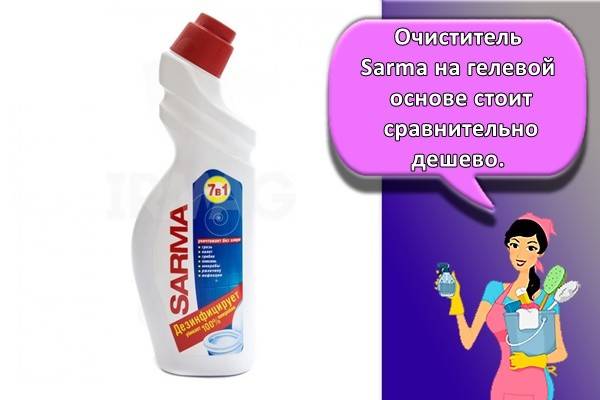
Vinegar
To eliminate dirt from the brush, a composition of two tablespoons of salt and four tablespoons of soda is used. Both components are mixed until homogeneous. Then three tablespoons of vinegar and boiling water are added to this composition. The resulting liquid is poured into a glass with a brush and kept for 1-1.5 hours.
Detergent
You can also wash the brush using a mixture that includes:
- 2 tablespoons of detergent;
- a quarter glass of vinegar;
- half a glass of soda;
- 2 tablespoons of baking soda.
The resulting mixture is also diluted with water and then poured into a glass with a toilet bowl cleaner.
Lemon acid
10 grams of citric acid should be mixed with a liter of water and a quarter cup of vinegar. After that, in the composition, you need to withstand the ruff for an hour.
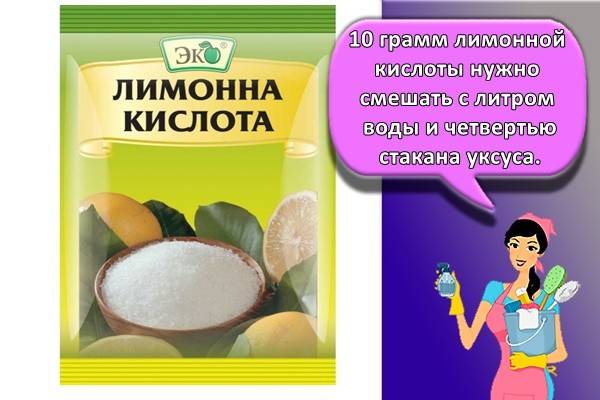
Leading manufacturers
The modern choice of brushes for the toilet is so diverse that the leading manufacturers of this product segment are trying to combine all the wishes of the buyer in one product, bringing the device in compliance with all stringent requirements for hygiene and durability.
Brabantia
Plastic and metal product. The chrome-plated holder will hide the brush. The base of the stand is provided with a plastic pad to prevent scratches on the surface. Convenient removal and re-installation: one side is completely closed, therefore hides all the details of the brush, and the other is open for convenient placement of the brush in the stand. It has a hard pile, is reliable and lightweight.
Features of cleaning with home remedies
A variety of homemade products can help in the cleaning process for stains and streaks. They are found in almost every home, and proper use will give no worse results than the use of expensive store products. These include citric acid, acetic acid, baking soda, and even plain Coca-Cola.
The use of citric acid
It has long been known that citric acid has good whitening properties. Therefore, this product is suitable for cleaning the toilet and will allow you to get the expected result of cleanliness and freshness. 3 tablespoons of powder should be poured inside the toilet, and the same amount into the cistern, wait a few hours, and then rinse off using a brush for more effective cleaning.
Using vinegar
Vinegar is another effective toilet cleaner. 70% vinegar is best, but you can use 9% table vinegar as well. It needs to be heated before use, so a glass of liquid is poured into a saucepan and put on fire. Warm vinegar is poured into the toilet, a few tablespoons of baking soda is added there and left for several hours. After that, you can rinse off the water several times and clean the inner surface with a brush. The inside of the cistern can also be washed out with vinegar.
Baking soda
Another homemade toilet bowl cleaner is baking soda, which you can find in every home. Many housewives know that this inexpensive product helps in cleaning many dirty surfaces, including it can easily wash off any marks and stains inside the toilet. 2-3 tablespoons of white powder should be poured into water, stir it with a brush and clean the faience, leave for several hours, and then rinse well several times. Such a procedure will be enough to get clean plumbing without streaks and contamination.
Coca-Cola use
There are many different stories and warnings written about this drink, but it is well known that Coca-Cola has corrosive properties. Therefore, its use for cleaning the toilet will give a good effect. To get the desired result, you need to take a few liters of the drink, pour it into the toilet and wait a few hours. The very first rinse will show what a good detergent it is.
How to clean a toilet with Whiteness
Whiteness is another home remedy to help fight plaque and deposits on the inside of plumbing fixtures. But its use is characterized by one feature: you must first remove all the water from the sanitary ware. And this is not always as easy as we would like. A liter of Whiteness is poured into a dry toilet bowl, left for 3-4 hours, or it is possible for the whole night. Then it is washed off with the usual amount of water.
The advantage of home cleaning products is the absence of an unpleasant odor and chemical fumes, that is, cleaning is not harmful to humans.
But you still need to take precautions so that cleaning the toilet is not only effective, but also safe for your health. Such measures include the use of rubber gloves for cleaning and a sufficient distance to keep your face from the area to be cleaned.
Application of specialized household chemicals
Today there is a huge amount of bathroom care products. We will list some of them:
- Silith Beng. This is a fairly well-known tool for cleaning bathrooms. The cost is 230 rubles. The product is based on hydrochloric acid. As the manufacturer notes, the substance allows you to get rid of urinary stones, traces of corrosion and limescale. Has a thick consistency. Among the shortcomings in the reviews, consumers note only a pungent smell. When working, it is advisable not to inhale vapors.
- Domestos. One of the leaders in the household chemicals market. The composition contains sodium hypochlorite. "Domestos" perfectly fights urinary stones and rust. Has a thick consistency. The cost of the product is 210 rubles. Disadvantage: the need for an even distribution, otherwise traces will remain on the surface. Also, the substance gives off a pungent odor.
- "Komet: 7 days of cleanliness." The product is based on sulfuric acid. The composition removes rust and limescale. The cost of the product is 220 rubles. Has a liquid consistency. Reviews note that this is a disadvantage, since the consumption of the product increases significantly. Like its previous counterparts, "Komet" emits a pungent odor when used.
- Sarma. This is the cheapest product there is. The price is 100 rubles. However, the composition can only overcome rust, it does not cope well with limescale. It has a thick consistency, the product is based on oxalic acid.
We decide for ourselves which product is better to use, but most people prefer to use Domestos or Silit. This "chemistry" is sold in any hardware store. Before use, you need to read the instructions, you need to work with the composition only with rubber gloves (even if there is no direct contact with the substance).
Recommendations
To make the hostess happy with the result of washing your beloved assistant, you can use the following recommendations:
- If it is possible to unscrew the removable elements, do it.
- Never use powders or other products with abrasive components.
- Avoid temperature extremes, do not wash the multicooker with cold water.
- After finishing washing, wipe the kitchen unit dry.
The quality of the multicooker cleaning depends on the choice of detergent.
Dishwashing liquid gel
Light daily dirt, deposits and grease are perfectly removed with a traditional liquid gel dishwashing detergent
After washing, it is important to completely rinse off the residues of the product and wipe the multicooker with a soft cloth dry
A soft sponge or cloth to wipe dry
When choosing a material for wiping, you should pay attention to the napiness of the napkin, rag or sponge. On the surface of the multicooker, especially on the heating element, there should be no pellets and hairs
They can burn or get into food. In addition, the napkin should be soft so as not to leave micro-scratches and damages on the surface.
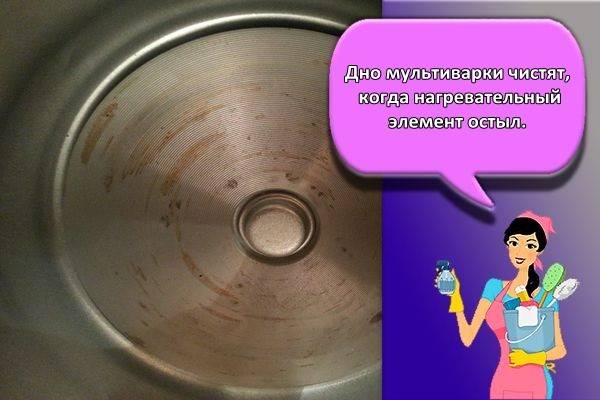
How do I clean the bottom?
The bottom of the multicooker is cleaned when the heating element has cooled down. Insignificant dirt can be easily removed with a damp cloth. When removing burnt fat, you can use baking soda or citric acid, which has a double effect: it removes stubborn stains and unpleasant odors, and also disinfects the surface. The bottom can be cleaned with cotton pads and a soft, lint-free cloth.
How do I clean the lid?
The lid of the multicooker is in close contact with the food being cooked. Consists of a steam valve, a surface and a rubber seal. To clean the lid properly, the elements must be disconnected.
Removable
All removable elements of the multicooker are washed separately, cleaned of old dirt, thoroughly rinsed, wiped dry and collected.
Fixed
When washing a fixed lid, cover the main part of the kitchen appliance with polyethylene and tilt it over the sink.After carrying out all the manipulations, household appliances are rinsed and wiped dry.
Cleaning the trash can
The moisture trap collects condensation and moisture residues after cooking. It must be washed after every cooking. The collected water is drained, and the container itself is washed with soapy water and wiped off with a soft sponge.
How to clean the steam valve
The correct taste and aroma of cooked dishes depends on the cleanliness of the steam valve (be it a Redmond or Polaris multicooker). If the steam valve is dirty, the steam does not find an outlet from the body of the pan, the cooked food "runs away", and often floods the heating element.

Leftover food and fat particles create an unpleasant smell inside the multicooker. First of all, the valve is washed with running warm water, then it is cleaned with a brush from dirt using citric acid, rinsed, wiped dry and set in place.
From the outside, the multicooker is cleaned using household chemicals. Melamine sponges and scouring powders can be used. In order to remove fingerprints from chrome-plated surfaces, you can use products containing ammonia.
How to care for septic toilets
It is important to learn how to properly care for plumbing without harming the autonomous sewer system. Familiar means, such as "Domestos", "Xylitol", "Komet" are suitable for this
It is imperative to purchase the above compositions and use only them. They are equally effective in treating urinary calculus, yellow plaque under the rim, and traces of feces. There are a lot of household chemicals in this line, the right choice guarantees the absence of an unpleasant odor from the sewer. The method of application is always indicated on the packaging.
Prevention of plumbing contamination
To reduce the amount of time and energy you spend cleaning and cleaning your toilet, preventative measures can be taken. The rules for maintaining cleanliness and order are not complicated, and their implementation will keep the toilet in good condition. These recommendations include:
- Monitor the health of the tank and the entire toilet bowl, prevent water leakage.
- Do not clog the toilet with foreign objects, especially those that do not get wet in water. Clearing a blockage is much more difficult than cleaning the surface of a plumbing fixture. Therefore, it is better not to allow this.
- Clean the toilet with a brush after each use.
- Use refreshing and cleaning agents - strips, balls, stickers under the rim, which will gradually dissolve with each rinse and fill the water with a weak cleaning agent.
Simple manipulations will help maintain a clean appearance of the toilet and reduce the frequency of general washing, as well as prevent the need for drastic measures.
Thus, there are many different products and methods to help you clean your toilet. It is up to each housewife to decide which drugs to choose, but if you try several of them, you can find the option that will be most effective and convenient to use. And then the appearance of the toilet will be pleasing, not annoying.

